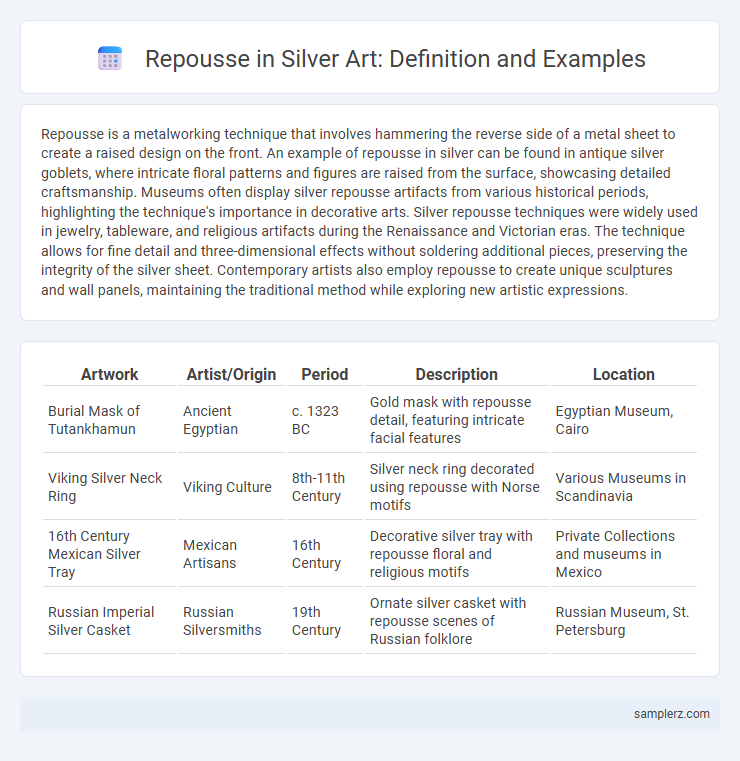Repousse is a metalworking technique that involves hammering the reverse side of a metal sheet to create a raised design on the front. An example of repousse in silver can be found in antique silver goblets, where intricate floral patterns and figures are raised from the surface, showcasing detailed craftsmanship. Museums often display silver repousse artifacts from various historical periods, highlighting the technique's importance in decorative arts. Silver repousse techniques were widely used in jewelry, tableware, and religious artifacts during the Renaissance and Victorian eras. The technique allows for fine detail and three-dimensional effects without soldering additional pieces, preserving the integrity of the silver sheet. Contemporary artists also employ repousse to create unique sculptures and wall panels, maintaining the traditional method while exploring new artistic expressions.
Table of Comparison
| Artwork | Artist/Origin | Period | Description | Location |
|---|---|---|---|---|
| Burial Mask of Tutankhamun | Ancient Egyptian | c. 1323 BC | Gold mask with repousse detail, featuring intricate facial features | Egyptian Museum, Cairo |
| Viking Silver Neck Ring | Viking Culture | 8th-11th Century | Silver neck ring decorated using repousse with Norse motifs | Various Museums in Scandinavia |
| 16th Century Mexican Silver Tray | Mexican Artisans | 16th Century | Decorative silver tray with repousse floral and religious motifs | Private Collections and museums in Mexico |
| Russian Imperial Silver Casket | Russian Silversmiths | 19th Century | Ornate silver casket with repousse scenes of Russian folklore | Russian Museum, St. Petersburg |
Introduction to Repoussé Technique in Silver Art
Repousse in silver art involves shaping the metal by hammering from the reverse side to create detailed, raised designs, showcasing intricate craftsmanship. This ancient technique allows artisans to produce elaborate textures and patterns on silver surfaces without the need for casting or engraving. Mastery of repousse requires precision tools and a thorough understanding of metal properties to achieve delicate relief work that highlights the reflective quality of sterling silver.
Historical Significance of Silver Repoussé
Silver repousse, an ancient metalworking technique, played a significant role in many cultures, notably in Byzantine and Renaissance art, where artisans crafted intricate religious icons and jewelry. This method allowed for detailed, three-dimensional designs embossed on silver sheets, enhancing the visual and tactile qualities of ceremonial objects. The historical significance lies in its ability to preserve cultural narratives and artistic traditions through durable, ornate silver artworks.
Iconic Silver Repoussé Artifacts in Museums
Iconic silver repousse artifacts such as the Gundestrup Cauldron, housed in the National Museum of Denmark, exemplify intricate craftsmanship with detailed mythological scenes embossed on silver plates. The British Museum's Anglo-Saxon silverware collection highlights the Sutton Hoo treasure, showcasing repousse techniques that reveal elaborate patterns and figures from early medieval England. These masterpieces demonstrate the historical significance and artistic sophistication of silver repousse across cultures and centuries.
Repoussé in Silver: Religious and Ritual Objects
Repousse in silver is a prominent technique used to craft intricate religious and ritual objects, often seen in chalices, reliquaries, and ceremonial plates adorned with sacred iconography. This method involves hammering the metal from the reverse side to create raised designs, enhancing both the visual and tactile qualities of devotional artifacts. Historically, silver repousse objects serve as tangible expressions of faith, combining artistry with spiritual significance in various cultural traditions.
Masterpieces of Repoussé Silver in Decorative Arts
Masterpieces of repousse silver in decorative arts showcase intricate designs formed by hammering the reverse side of malleable silver to create raised reliefs. Notable examples include the British Museum's 16th-century silver ewers and the Indian Mughal Empire's ornate silver plaques adorned with floral and geometric patterns. These artworks highlight the technique's ability to merge functionality with elaborate artistry, preserving cultural narratives through detailed metalwork.
Famous Silversmiths Known for Repoussé
Renowned silversmiths such as Paul Revere and Georg Jensen are celebrated for their exceptional repousse work, showcasing intricate designs raised from the surface of silver. Their mastery in this technique highlights detailed floral motifs and elaborate scenes that demonstrate high craftsmanship and artistic expression. These artists significantly contributed to the popularity and evolution of repousse in decorative silverware.
Contemporary Silver Repoussé Artists and Works
Contemporary silver repousse artists like William Harper and Satomi Kaneko push the boundaries of metalwork with intricate designs that marry tradition and innovation, creating dynamic reliefs that capture light and texture. Harper's silver repousse bowls showcase delicate floral motifs rendered in high relief, while Kaneko's sculptural jewelry uses this technique to highlight organic forms and fine details. These artists' works exemplify how repousse continues to evolve within contemporary silver art, blending craftsmanship with modern aesthetics.
Repoussé in Silver Jewelry Design
Repousse in silver jewelry design involves shaping intricate patterns by hammering from the reverse side of the metal to create raised motifs. This technique enhances the dimensionality and texture of silver pieces, commonly seen in traditional Native American and Art Nouveau jewelry. Master silversmiths utilize repousse to craft detailed floral and geometric designs that elevate the artistic value and uniqueness of each jewelry item.
Step-by-Step Process: Creating Repoussé in Silver
Repousse in silver involves carefully hammering the metal from the reverse side to create a raised design, starting with a detailed sketch transferred onto the silver sheet. The silver is softened through annealing, then shaped using various chasing tools and hammers to refine the contours and textures. Final steps include polishing and burnishing the raised areas to enhance contrast and highlight the intricate relief patterns characteristic of repousse work.
Preserving and Restoring Silver Repoussé Artworks
Preserving and restoring silver repousse artworks require specialized techniques to maintain their intricate raised patterns and prevent tarnishing caused by oxidation. Conservation experts use gentle cleaning agents and controlled environments to safeguard the metal's luster while repairing any deformations or cracks without compromising the original craftsmanship. Advanced methods such as micro-welding and laser cleaning restore structural integrity and surface detail, ensuring the longevity of these delicate, historically significant silver pieces.

example of repoussé in silver Infographic
 samplerz.com
samplerz.com